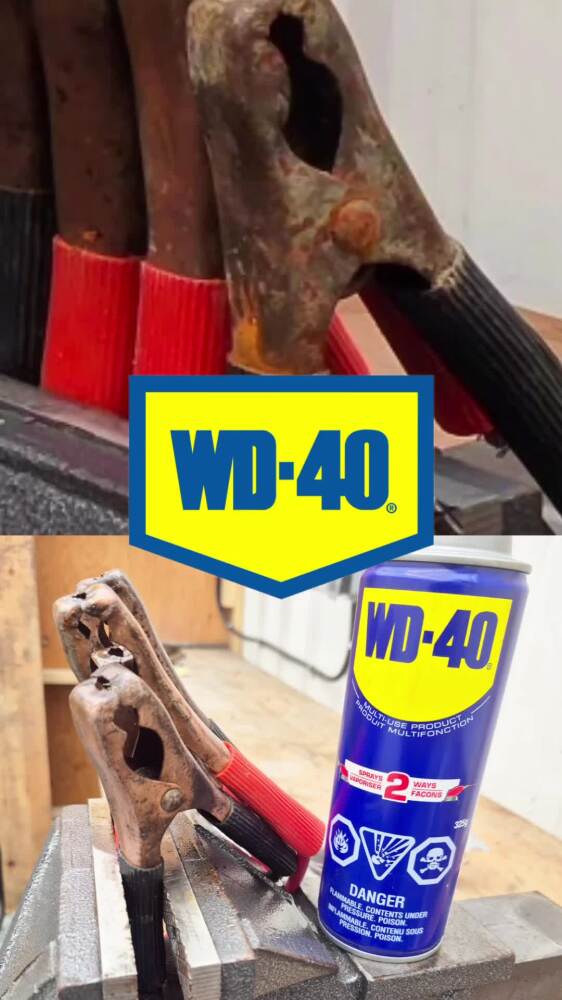The Day WD-40 Jump-Started My Business (Literally!)



Plus 1 more
It was the start of a busy workday for my landscaping business, and I headed out to fire up my trusty lawn tractor. To my dismay, I'd accidentally left it on auxiliary overnight, draining the battery completely. My first thought was to grab my old jumper cables – the ones I rarely use.
Upon inspecting them, it was clear why they were neglected. They were heavily rusted and corroded, especially near the clamps. When I tried to test them by creating a small arc with a battery, there was absolutely no power transfer. The cables were so far gone that wires were frayed and corroded right where they met the alligator clips.
Undeterred, and knowing the power of WD-40, I snipped off the damaged sections. Then, I carefully reinserted the healthy wire into the alligator clip. With the connections looking better, I then used WD-40 to thoroughly scrub away the remaining rust on the clamps and cables. As I worked, the rust simply melted away, and the cables began to gleam. Not only did it clean them, but it also protected them from future corrosion, essentially restoring them to like-new condition.
Confident in WD-40's magic, I connected the "rejuvenated" jumper cables to my lawn tractor. With a turn of the key, the engine roared to life! My business was back on track, all thanks to WD-40. It truly is amazing how one product can save the day – and my tools!
Step 1: Reviving Rusty Jumper Cables with WD-40

Step-by-Step Guide: Reviving Rusty Jumper Cables with WD-40
Tools & Materials You'll Need:
Rusty Jumper Cables
Wire cutters/strippers
WD-40 Multi-Use Product
Wire brush (optional, for stubborn rust)
Clean rag or paper towels
A fully charged battery (for testing)
Safety glasses and work gloves
Step 2: Assess and Prepare the Cables (with Safety First!)

First, ensure you're wearing safety glasses and work gloves to protect your eyes and hands from rust particles and potential wire splinters. Carefully inspect your jumper cables, paying close attention to the alligator clips and the points where the cable meets the clips. Look for heavy rust, corrosion, and especially any frayed or broken wires right at the connection points.
Step 3: Snip & Re-Secure Damaged Connections

If you find sections where the wire is frayed or heavily corroded right where it enters the alligator clip, use your wire cutters to snip off the visibly bad portion of the cable. Then, carefully strip back a small amount of insulation (just enough to expose fresh copper wire) and re-insert the clean wire securely into the alligator clip's connection point. If possible, crimp or tighten the connection to ensure good contact.
Step 4: Apply WD-40 to Rusty Areas

Now for the star of the show! Generously spray WD-40 Multi-Use Product directly onto all rusted and corroded areas of the alligator clips, including the pivot points and any visible rust on the cable itself. Don't be shy – let the WD-40 penetrate the rust.
Step 5: Scrub Away the Rust

Allow the WD-40 to sit for a few minutes to begin breaking down the rust. Then, use a wire brush (if the rust is stubborn) or a clean rag to scrub vigorously at the rusted areas. You'll see the rust begin to dissolve and wipe away, revealing cleaner metal underneath. Continue scrubbing and wiping until the clamps and cables are as clean and rust-free as possible. The WD-40 will also leave a protective film to help prevent future rust.
Step 6: Test for Conductivity

Once cleaned, it's crucial to test your cables. Connect one clamp to the positive (+) terminal of a good battery and the other clamp to the negative (-) terminal. You should see a small spark, indicating power flow. If possible, use a multimeter to confirm full conductivity. This step ensures the cables are now properly transmitting power.
Step 7: Jump Start Your Vehicle

With your "restored" jumper cables now clean and functional, you're ready to jump start your vehicle as you normally would. Connect the cables correctly (positive to positive, negative to negative, ensuring the final ground connection is on the engine block or a non-painted metal part away from the battery). Start the good vehicle, then try to start your vehicle with the dead battery.
Thanks to WD-40, your old, rusty jumper cables are ready to power you up again!


